The most famous Italian meat sauce for pasta is of course the one from Bologna: ragù alla bolognese. And with reason: if made properly it can be divine. Outside of Italy (or inside of Italy in tourist traps) it is often served over spaghetti. But “alla bolognese” means “like they do it in Bologna”. And in the city of Bologna, ragù is served on pasta ribbons made with egg, preferably fresh pasta. Which of course is locally just called “tagliatelle al ragù”, as it is implied that the ragù is the local version.
In this post I use traditional ingredients for the ragù, but what I changed is the method for cooking the meat. In an earlier post I already compared ragù prepared the traditional way on the stovetop with pressure cooked and sous-vide. Since then I have however developed an improved method of preparing the ragù sous-vide that I would like to share with you in this post. In hindsight I did something wrong in the previous post, and that is cooking the ground meat sous-vide after it had already been browned (and thus was already heated well above the sous-vide cooking temperature). Although in some ways this is an improvement over the traditional version (where the meat is effectively boiled and thus becomes dry and ‘gritty’), the result with the method presented in this post is much better.
Many recipes for ragù will tell you to brown the meat well to develop the flavor. This is true, as the Maillard reactions will create a lot of flavor. But at the cost of the texture, as it will also make the meat dry and gritty. To get the best of both worlds, start with the meat still in larger pieces (like steaks) and brown the meat like that. The meat will remain raw on the inside. Then grind the meat, so that you end up with a mixture with browned meat for flavor and raw meat that will have a perfect texture once cooked sous-vide. Of course the browned flavors created in the pan should also be used.
This recipe is not very quick, as you still need to reduce the sauce without the meat (as there is no reduction in sous-vide cooking), but the reduction can be achieved a bit faster as you don’t have to worry about overcooking the meat. And the sous-vide step itself takes 24 hours, so if you want to have this for dinner on Sunday, you better start Saturday morning. But it is worth it. Both flavor and texture of this ragù are phenomenal.
The ragù freezes very well, so it is a great idea to make a large batch and then cook it sous-vide in portions and freeze them for later use. Defrosting and reheating should of course be done sous-vide. If you freeze the sauce in a flat shape, that should take less than an hour.
Ingredients
Makes about 3 kilos (6.6 lbs), enough to dress 20 portions of pasta
1.5 kilograms (3.3 lbs) veal or beef, in steaks
250 grams (9 oz) prosciutto, minced
250 grams (9 oz) pancetta, minced
1.5 kilograms (53 oz) sieved tomatoes (tomato puree, passata di pomodoro)
250 grams onion, minced
250 grams celery, minced
250 grams carrots, minced
300 ml (1 1/4 cup) red or white wine
600 ml (2 1/2 cups) whole milk
freshly grated nutmeg
salt and freshly ground black pepper
extra virgin olive oil
Instructions
Heat a generous amount of olive oil in a large casserole (Dutch oven). Brown the meat in batches, so the casserole is not crowded.
The meat should be nicely browned on the outside, but remain raw on the inside. Reserve the meat and allow to cool. Once it has cooled down to room temperature, put it in the refrigerator (covered with plastic wrap).
The drippings that will be left in the casserole contain a lot of flavor, so make sure to use them for the sauce.
Add minced celery, carrot, onion, prosciutto, and pancetta to the drippings. Add more olive oil if needed.
Brown this mixture over medium-high heat, stirring regularly, until it starts to sizzle (indicating that most of the moisture is gone).
Add the wine.
Bring to a boil and cook until most of the wine has evaporated, stirring regularly.
Add the tomatoes.
Stir and bring to a boil, then reduce the heat to a nice simmer.
Add any juices that will have leaked from the reserved meat.
Add freshly grated nutmeg.
Allow the sauce to bubble over low to medium heat until it is no longer ‘watery’, stirring regularly. This could easily take an hour.
Add the milk.
Stir and bring to a boil again, then allow to reduce over low heat, stirring regularly…
…until the sauce has reduced to the right thickness. There will be no more reduction after this. Again this could easily take an hour.
Season to taste with salt and freshly ground black pepper.
Allow the sauce to cool. You can speed up this process by immersing the casserole in cold water.
While the sauce is cooling, it is time to grind the meat. Take it out of the refrigerator.
Cut it into chunks that will fit into the feeding tube of the meat grinder. As you can see, the meat is still raw on the inside.
Grind the meat…
…until you have ground all of it.
Once the sauce has cooled to room temperature, add the ground meat. Add 2 tsp of salt.
Stir to mix it well.
Vacuum seal in individual portions. 300 grams of ragù is 2 servings. The easiest is to use a chamber vacuum sealer. If you don’t have one, you could probably vacuum seal the ragù using a FoodSaver-type vacuum sealer once the ragù has cooled down in the refrigerator. If not, you could also freeze it first (in open bags) and then vacuum seal once frozen. Or use ziploc bags and the water displacement method.
Cook the ragù sous-vide for 24 hours at 74C/165F. It is probably most efficient to cook the whole batch at once, and freeze what you don’t need at once to reheat later. If you freeze the ragù in a flat shape, you can defrost and reheat it at 74C/165F in about an hour.
To dress pasta with the ragù, preheat a pan over low heat and pour the contents of a bag into it. Taste and adjust the seasoning with salt and freshly ground black pepper.
Add the cooked and drained pasta together with freshly grated parmigiano reggiano (about 25 grams or 1 oz for 2 servings).
Stir to mix.
Serve at once on preheated plates, sprinkled with some more parmigiano.
Wine pairing
This is great with Sangiovese-based wines. A great and appropriate choice would be a Sangiovese di Romagna, but others such as Chianti would also work.
Flashback
These date, oat bran, and quark muffins are nutritious and delicious, without any added sugar. There is no butter either. No baking skills required, just a food processor or blender.

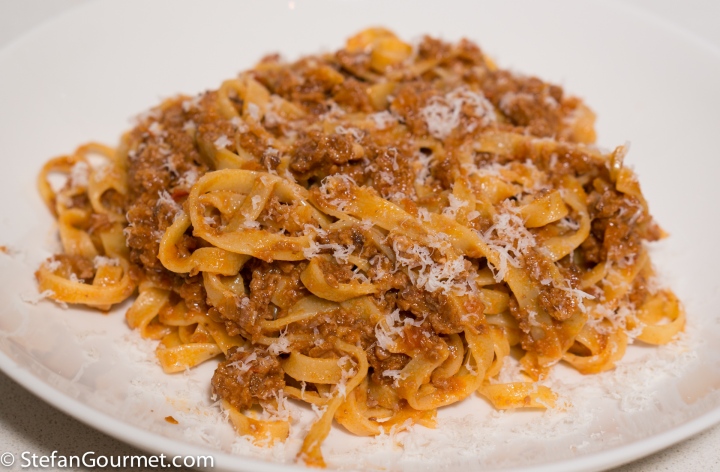


















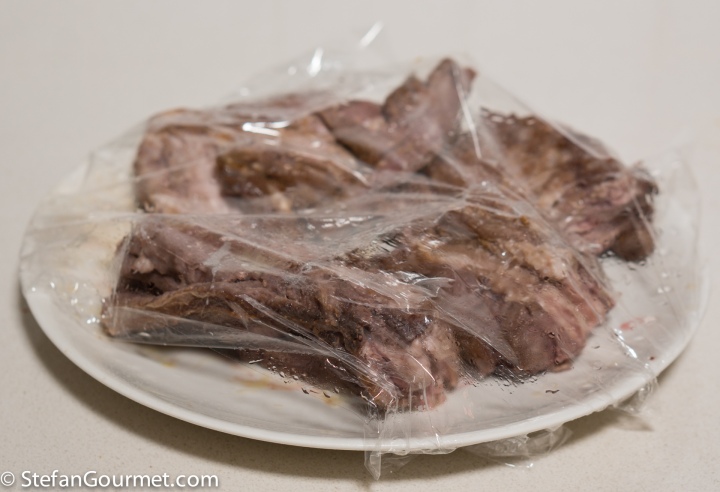
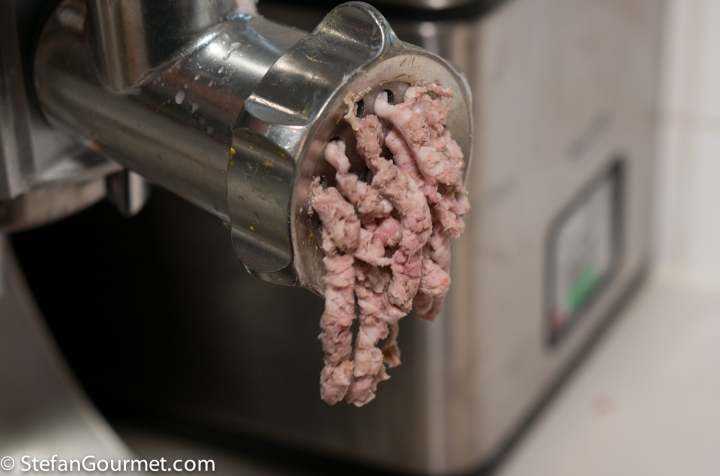
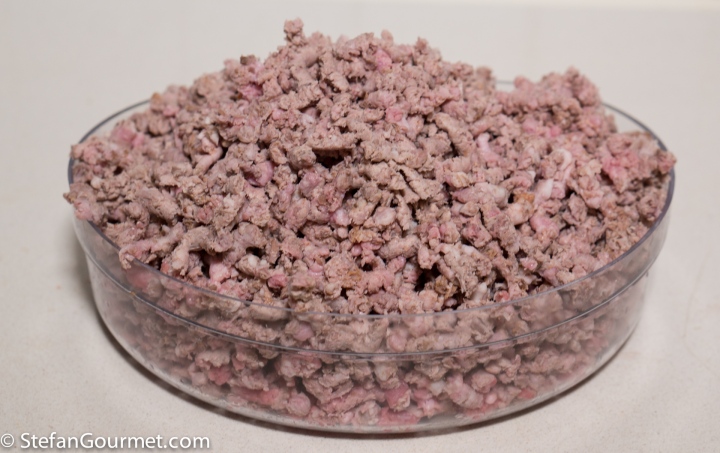



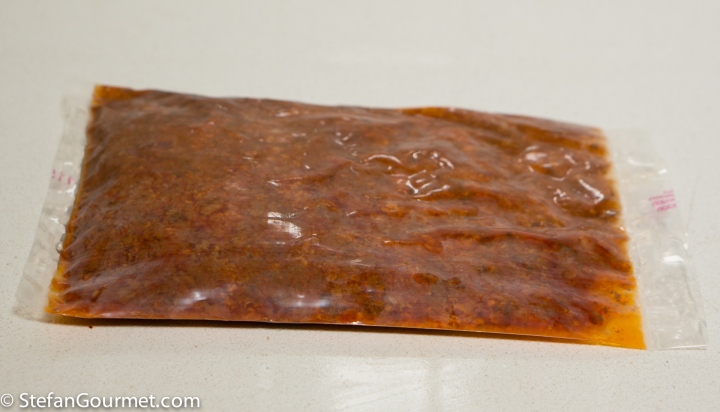





I love Bolognese, especially true Italian. 🍃🍅
LikeLiked by 2 people
That’s wonderful! I cannot wait to get my chamber vacuum sealer for Christmas!
LikeLiked by 1 person
Good looking dish 🙂
Cheers !
LikeLiked by 1 person
Valuable lessons learnt : Using both prosciutto and pancetta. Beef, passata and red wine . . . have done large batches before but shall copy you next time around . . ; my world, my way 🙂 !
LikeLiked by 1 person
Lots of steps to produce what looks like a delicious plate of food Stefan.
LikeLiked by 1 person
well done stef! it does make sense.
just one comment: the tomato conversion: surely 1 .5 kg of passata is not the same as purè or sieved tomatoes… or I am not getting it?
..I prefer to use far less tomato purè (never passata or sieved toms) and then stock to dilute it.
what cuts of meat did u use? what about beef bavette of jowl?
thanks and thanks for sharing this interesting experiments
s
LikeLiked by 1 person
Ciao Stefano,
Sieved tomatoes is the literal translation of passata di pomodoro; descriptions in both languages are often found on bottles or cartons.
In the United States, this is called tomato puree. That is confusing, as in other languages tomato puree refers to tomato paste (concentrato di pomodoro). As far as I am aware, “purè di pomodoro” is not a usual term in Italian.
Tomato paste with stock is also a good way to make bolognese, but it is not what is written in the ‘official’ recipe. Perhaps I should do a side by side 🙂
LikeLiked by 1 person
Il ragù alla bolognese è un ero confort food. Sai che Bottura ha preso la seconda stella Michelin proprio con il suo ragù?
LikeLiked by 1 person
No, non lo sapevo. Il piatto che ricordo da lui è un risotto con scalogno, porro e tartufo.
LikeLiked by 1 person
sarà stato super
LikeLiked by 1 person
This is definitely taking low and slow to an entirely new level! Nicely done. Ragu is one of my husband’s favourites and it looks like your version is quite flavourful with all of the variety of meat you have listed. We generally toss in a pinch of baking soda into tomato sauces to help neutralize the acidity, I honestly could not eat it without this little bit. It’s not enough to taste but it does a number on the acidity.
LikeLiked by 1 person
The milk is used for that purpose in this recipe.
LikeLike
Interesting tip, thanks
LikeLiked by 1 person
Stefan, I’ve had repeated seal failures using a Foodsaver system and had been considering a Vacmaster chamber sealer. Your recipe for ragu sealed the deal (forgive the pun). What size pouch (inches) works best for 300 g portions? Thanks!
LikeLiked by 1 person
Chamber sealers are great. I use 6 x 10 inch bags for 300 g ragù portions.
LikeLike
Which cuts are used for this minced meat? Welke vleesdelen kan ik het beste hiervoor gebruiken? Bedankt Jos
LikeLike
Beef chuck, riblappen in Dutch. You can find the Dutch recipe here: https://sousvidekoken.blog/2018/11/05/pasta-bolognese-sous-vide/
LikeLike